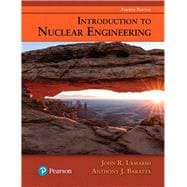For junior- and senior-level courses in Nuclear Engineering.
Applying nuclear engineering essentials to the modern world
Introduction to Nuclear Engineering , 4th Edition reflects changes in the industry since the 2001 publication of its predecessor. With recent data and information, including expanded discussions about the worldwide nuclear renaissance and the development and construction of advanced plant designs, the text aims to provide students with a modern, high-level introduction to nuclear engineering. The nuclear industry is constantly in flux, and the 4th Edition helps students understand real-world applications of nuclear technology—in the United States and across the globe.
John R. Lamarsh (deceased) was the head of the nuclear engineering department at the Polytechnic Institute of New York (now the New York University Tandon School of Engineering). He was considered an expert on nuclear energy policy and safety, nuclear weapons proliferation, and was appointed administrative judge of the Federal Nuclear Regulatory Commission. He served as a consultant to the Brookhaven National Laboratory, the National Science Foundation, the Federal Office of Technology Assessment and the Library of Congress. He was the author of many articles and several textbooks, including ''Introduction to Nuclear Engineering'' and ''Nuclear Reactor Theory.''
Anthony Baratta received the B.A/B.S. degrees in physics/applied physics from Columbia University in 1968 and the M.S. and Ph.D. degrees in physics from Brown University in 1970 and 1978, respectively. He is Professor Emeritus of Nuclear Engineering, The Pennsylvania State University retiring in 2003. While at Penn State, his research interests and contributions include reactor safety, reactor kinetics and physics, and the effects of radiation on materials. He has authored many scientific publications and made numerous presentations.
After his retirement he was appointed as the Associate Chief Judge of the Atomic Safety and Licensing Board Panel, US Nuclear Regulatory Commission where he served until 2015. He is currently a part-time judge with the panel and an active member of the American Nuclear Society. He has appeared on many network television and radio broadcasts as an authority on reactor accidents, including the accidents at Three Mile Island and Fukushima.
1. Nuclear Engineering
2. Atomic and Nuclear Physics
2.1 Fundamental Particles
2.2 Atomic and Nuclear Structures
2.3 Atomic and Molecular Weights
2.4 Atomic and Nuclear Radii
2.5 Mass and Energy
2.6 Particle Wavelengths
2.7 Excited States and Radiation
2.8 Nuclear Stability and Radioactive Decay
2.9 Radioactivity Calculations
2.10 Nuclear Reactions
2.11 Binding Energy
2.12 Nuclear Models
2.13 Gases, Liquids, and Solids
2.14 Atom Density
References
Problems
3. Interaction of Radiation with Matter
3.1 Neutron Interactions
3.2 Cross Sections
3.3 Neutron Attenuation
3.4 Neutron Flux
3.5 Neutron Cross Section Data
3.6 Energy Loss in Scattering Collisions
3.7 Fission
3.8 y-Ray Interactions with Matter
3.9 Charged Particles
References
Problems
4. Nuclear Reactors and Nuclear Power
4.1 The Fission Chain Reaction
4.2 Nuclear Reactor Fuels
4.3 Non-Nuclear Components of Nuclear Power Plants
4.4 Components of Nuclear Reactors
4.5 Power Reactors and Nuclear Steam Supply Systems
4.6 Nuclear Cycles
4.7 Isotope Separation
4.8 Fuel Reprocessing
4.9 Radioactive Waste Disposal
References
Problems
5. Neutron Diffusion and Moderation
5.1 Neutron Flux
5.2 Fick’s Law
5.3 The Equation of Continuity
5.4 The Diffusion Equation
5.5 Boundary Conditions
5.6 Solutions of the Diffusion Equation
5.7 The Diffusion Length
5.8 The Group-Diffusion Method
5.9 Thermal Neutron Diffusion
5.10 Two-Group Calculation of Neutron Moderation
References
Problems
6. Nuclear Reactor Theory
6.1 One-Group Reactor Equation
6.2 The Slab Reactor
6.3 Other Reactor Shapes
6.4 The One-Group Critical Equation
6.5 Thermal Reactors
6.6 Reflected Reactors
6.7 Multigroup Calculations
6.8 Heterogeneous Reactors
References
Problems
7. The Time-Dependent Reactor
7.1 Classification of Time Problems
7.2 Reactor Kinetics
7.3 Control Rods and Chemical Shim
7.4 Temperature Effects on Reactivity
7.5 Fission Product Poisoning
7.6 Core Properties During Lifetime
References
Problems
8. Heat Removal from Nuclear Reactors
8.1 General Thermodynamic Considerations
8.2 Heat Generation in Reactors
8.3 Heat Flow by Conduction
8.4 Heat Transfer to Coolants
8.5 Boiling Heat Transfer
8.6 Thermal Design of a Reactor
References
Problems
9. Radiation Protection
9.1 History of Radiation Effects
9.2 Radiation Units
9.3 Some Elementary Biology
9.4 The Biological Effects of Radiation
9.5 Quantitative Effects of Radiation on the Human Species
9.6 Calculations of Radiation Effects
9.7 Natural and Man-Made Radiation Sources
9.8 Standards of Radiation Protection
9.9 Computations of Exposure and Dose
9.10 Standards for Intake of Radionuclides
9.11 Exposure from y-Ray Sources
Glossary
References
Problems
10. Radiation Shielding
10.1 Gamma-Ray Shielding: Buildup Factors
10.2 Infinite Planar and Disc Sources
10.3 The Line Source
10.4 Internal Sources
10.5 Multilayered Shields
10.6 Nuclear Reactor Shielding: Principles of Reactor Shielding
10.7 Removal Cross Sections
10.8 Reactor Shield Design: Removal—Attenuation Calculations
10.9 The Removal—Diffusion Method
10.10 Exact Methods
10.11 Shielding y-Rays
10.12 Coolant Activation
10.13 Ducts in Shields
References
Problems
11. Reactor Licensing, Safety, and the Environment
11.1 Governmental Authority and Responsibility
11.2 Reactor Licensing
11.3 Principles of Nuclear Power Plant Safety
11.4 Dispersion of Effluents from Nuclear Facilities
11.5 Radiation Doses from Nuclear Plants
11.6 Reactor Siting
11.7 Reactor Accidents
11.8 Accident Risk Analysis
11.9 Environmental Radiation Doses
References
Problems
Appendixes
I. Units and Conversion Factors 743
II. Fundamental Constants and Data 749
III. Vector Operations in Orthogonal Curvilinear Coordinates 759
IV. Thermodynamic and Physical Properties 765
V. Bessel Functions
Index

